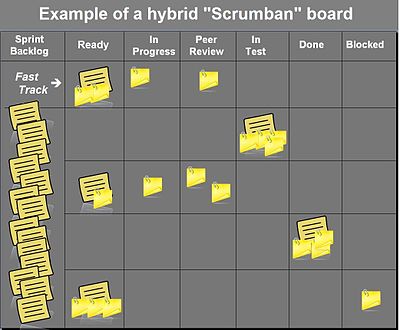Getting Real with Scrumban
Join the DZone community and get the full member experience.
Join For FreeI've been working as a Scrum Master and as an Agile Coach for a good few years now, mainly as a contractor. Each time I am interviewed for a new contract I always like to ask if I can meet the teams I’d be working with. You see, time and again it will be a manager who does the interviewing, while the team members themselves are left with little say in whether I should be hired. I think it’s important that they reckon they can get along with me. Of course, it also gives me an opportunity to see them, and to gain a fuller understanding of the situation I’d really be walking into.
As we head towards the desks of my prospective team, one of the first things I look for is the board, whether it be a Scrum task board or a Kanban board. Most teams with agile aspirations…or agile pretensions…will have set up a board of some kind. A board is the "grand old dame" of information radiators. No matter how much the details of a sordid past are glossed over, the truth always seems to come out. It's in the nature of a board to tell the truth, since any untruths can be quickly exposed. The story I can piece together from dubious lanes and columns, misplaced or missing tickets, misplaced or missing avatars, and a host of other shibboleths can be far more telling than anything I get to hear from people in an interview situation.

Another of the things I look for is a "fast track" lane on a Scrum Team's board. These are very common; you could say it is almost unusual not to see them. From a certain perspective they are good things to have, and they can imply a level of maturity - or at least of pragmatism - on the part of a team. They suggest that the team accepts that not everything can be predicted in Sprint planning. A fast track lane is a nod to the fact that emergencies happen, that support work and unforeseen defect fixes still need to be done, and most importantly, that the team has a way of dealing with all of this.
However it also shows that they aren't doing Scrum.
There...I've said it. Fast track lanes aren't part of Scrum. It's that simple. I don't mean to say that they are bad practice, or in some sense un-agile. On the contrary, they are part of the Lean Kanban approach to varying the Quality of Service provided to certain backlog items. That's what a fast track lane is...a way of varying the quality of service that a Scrum team gives to certain items. When something hits a fast track lane, a well-trained team will swarm over it and decide who is best qualified to progress the matter. While they do this, their own tasks will be marked as impeded or blocked. Then, the decision made, all others return to their work in progress.
So if fast track lanes are a widely understood and practical way of managing operational issues, what is wrong with them, Scrum-wise?
The answer is that Scrum - unlike Lean Kanban - doesn't provide for variations in quality of service. Each piece of work is prioritized and negotiated into a Sprint backlog. The team then self-organizes to deliver a corresponding increment of functionality. The team will plan with the Product Owner what it intends to do during a sprint, and the sprint backlog they agree to belongs to them. No-one, not even the CEO of the organization, can override their sprint backlog by introducing work to be "fast tracked". The team wholly owns their sprint backlog. That's Scrum.
When I point this out, teams can become crestfallen or even defensive. “What else are we supposed to do”, they say. “We aren’t dedicated 100% to doing project work. We still have support work to do, and serious issues always trump development. We have to fix them and put project work on hold.”
My answer to that is that under the circumstances the team is facing, it may indeed be right to vary the quality of service by fast-tracking support work. It just isn’t Scrum, that’s all. It’s a type of "Scrumban", a Scrum variant that includes Kanban characteristics. This is no fault of the team, but it could suggest a problem higher up. Perhaps a dedicated Kanban support team hasn’t been properly resourced and trained so that Scrum development can proceed unimpeded. Perhaps the Product Owner is being undermined by other managers who have separate interests impacting the development. Whatever the situation, it needs to be made transparent and acknowledged by all stakeholders.
So, the next step…and the one I’ll often indicate as the interview progresses…is to account for fast track work as impediments against product burndown or velocity. Moreover, these are impediments which are external to the team. It’s essentially a type of waste, or unplanned work, being generated from outside. It needs to be made quite transparent where this waste is coming from and what can be done to mitigate it. What can be done about those other teams, or workflows, or managers, who are undercutting this Scrum team’s ability to plan out their Sprints? Often, the source of these impediments will be the people interviewing me...and that’s when things can start to get really interesting!
Opinions expressed by DZone contributors are their own.

Comments